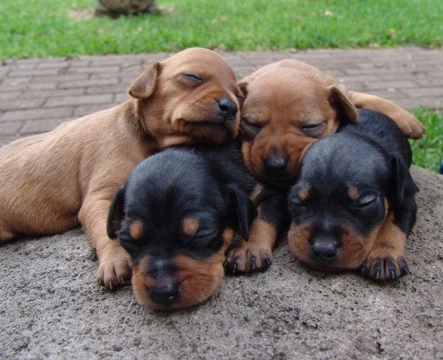
Can dogs have a litter from two different sires?
It might come as a surprise to dog owners, but it is entirely possible if not that common for a bitch to produce a litter that is sired by two different males dogs. As breeding is usually a carefully planned procedure, people planning to breed from their bitches are generally very careful to ensure that their bitch is kept away from male dogs when in season, other than potentially the dog that they wish to mate their bitch to. However, there are few things more persistent than dogs and bitches possessed with the urge to breed, and even with careful management, a bitch in heat may potentially escape or come into contact with other dogs when in season, and conceive without human intervention!
This means that even a bitch that undergoes a planned breeding cycle can potentially be “covered” (impregnated) by more than one male dog if they happen to have the opportunity, or if you find that your bitch has conceived without your knowledge, again, there is the potential for two different dogs to father the same litter.
Read on to learn more about the phenomenon of multiple sires of a bitch’s litter.
The reproductive cycle
Adult female dogs that are not spayed usually come into heat around every six months, and during this time they are both capable of and receptive to the idea of reproduction. Bitches can remain in season for up to three weeks at a time, and at some point during their season they will ovulate, which is the point at which they are capable of conceiving if mated to a sire. It is not possible to tell precisely when in the oestrus cycle your female dog will ovulate, and so there is no sure-fire way to know when the risk of conception has passed. Female dogs will produce several eggs during ovulation, over the course of several days. This means that there are multiple eggs viable for fertilization during ovulation, and that the bitch remains able to conceive for several days at a time.
Impregnation
Impregnation occurs when a female dog mates with a male, and his sperm fertilises one or more of her eggs. As well as fertilisation, the egg must implant into the nutrient-rich lining of the womb, where it will begin to develop into the ultimate puppies. As the bitch produces several eggs during ovulation and they can remain viable for fertilisation for several days, it is entirely possible that once one egg has been fertilized and implanted within the womb, other eggs remain viable for fertilisation too.
Multiple sires
If a bitch mates with more than one dog during the ovulation stage of her season, she may well become pregnant with a mixture of fertilised eggs from more than one sire. The closer together the matings fall, the greater the chances that more than one egg will be fertilised by more than one dog, as once a fertilised egg is implanted and begins to develop in the womb, the fertile period or season will begin to come to an end.
The concept of one pregnancy with multiple sires is known as heteropaternal superfecundation. Superfecundation means fertilisation of more than one egg with more than one sperm, while heteropaternal means “different fathers.” Sometimes, the term “superfecundation” on its own is used to describe this phenomenon, although this is not strictly correct, as superfecundation can still occur with only one sire, and commonly does in litters with just one father but several puppies that are not paternal twins.
Indications of multiple sires of a litter
If you know or suspect that your bitch has been covered by more than one sire, there is a possibility that the litter will contain puppies from each father, although this is by no means a given. You should, however, be prepared for this possibility! If you are absolutely certain that your bitch has only mated with one dog, multiple sires of the litter are of course not possible- unless your bitch managed to get out or meet another male without your knowledge!
If you are not sure what dogs your bitch came into contact with while in season, or the pregnancy comes as a surprise to you, then again, you should look out for the signs of a potentially mixed litter.
Puppies from within the same litter but different fathers will generally be similar sizes unless the respective sires were significantly different sizes, but the colouration, conformation and physical appearances of the puppies might vary considerably. This may only become apparent when the puppies begin to grow a little larger, as newborn puppies tend not to display all of the traits that they will develop as they grow!
Can you register puppies with multiple sires?
If your bitch is purebred and you intended to register her puppies as pedigree offspring with The Kennel Club, you might be wondering if this is still possible in the case of a multi-sire birth. This can technically be achieved, but you must be able to definitively identify at least one of the sires of the puppies, and in turn, that sire must be a pedigree dog of the same breed as the dam.
DNA testing must then be performed on the identified sire and the puppies of the litter to formally identify which of the puppies are pure bred and what dog is the sire, and so, it is possible to have one litter where some of the puppies are pedigree and registered, but some of their siblings are not!



